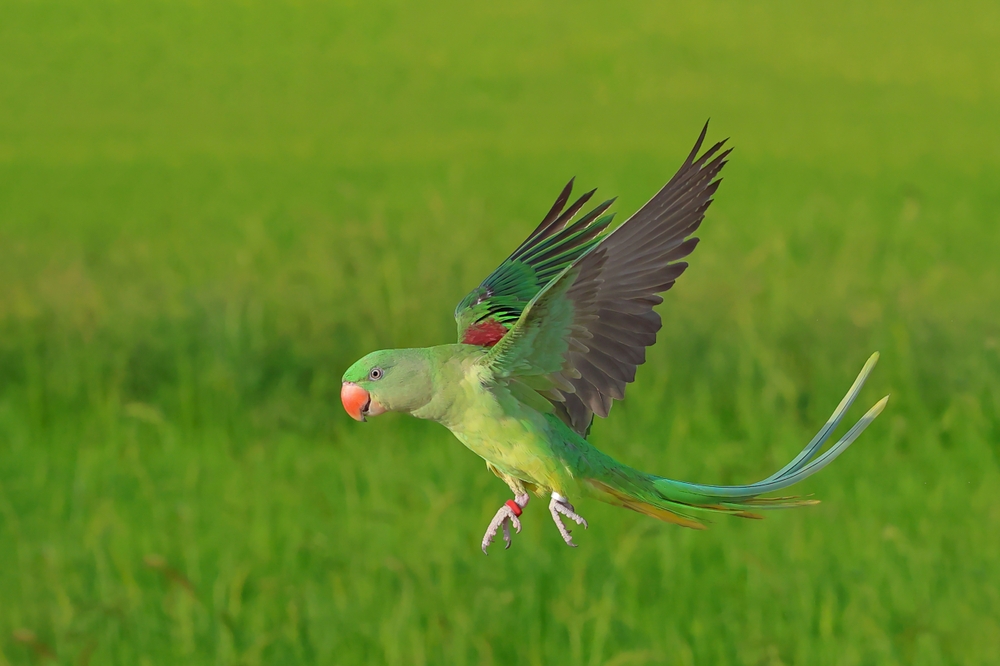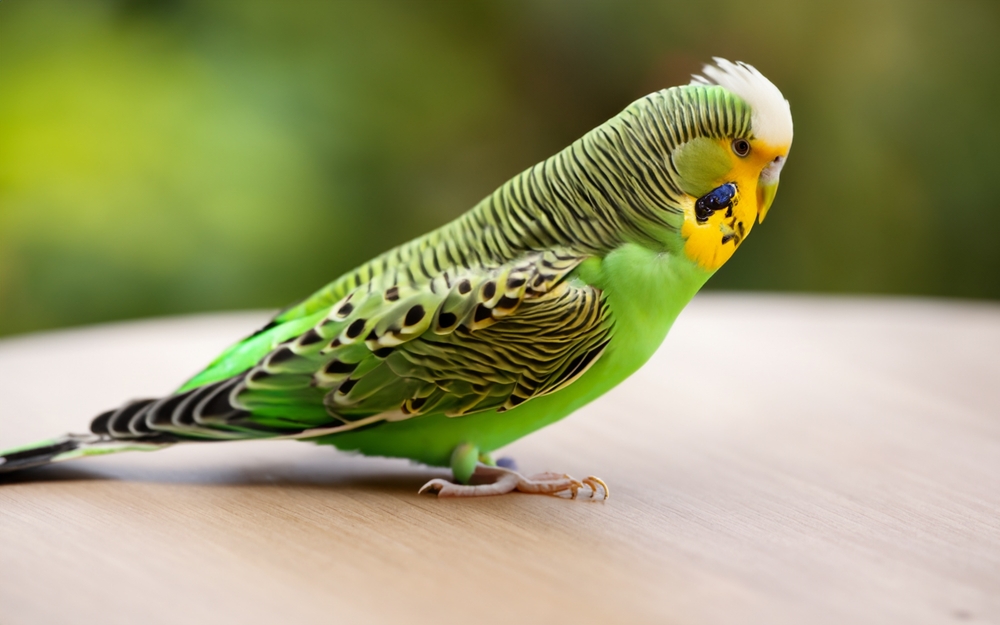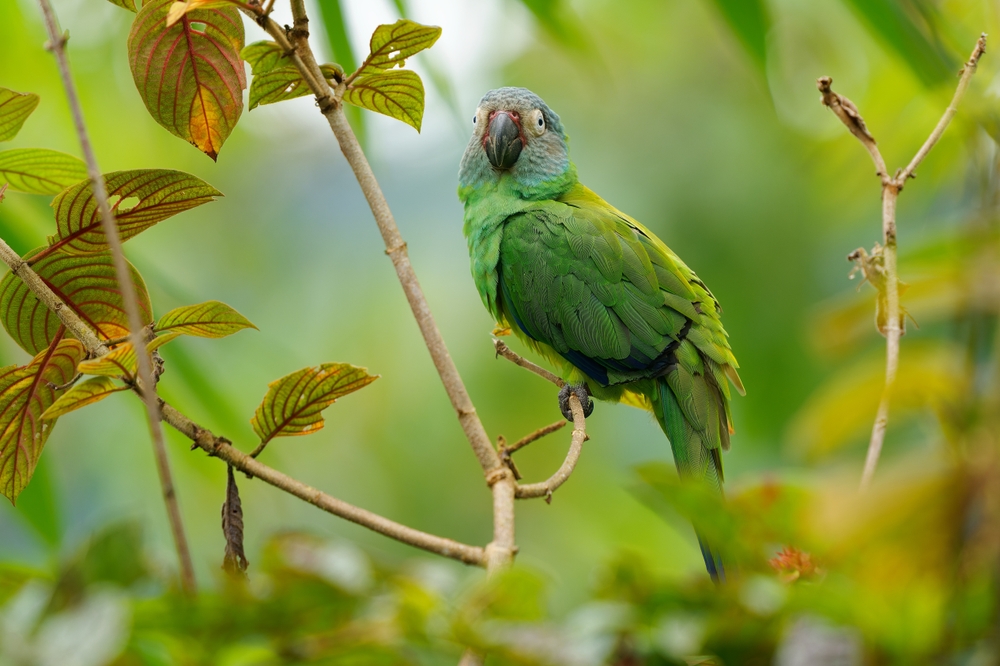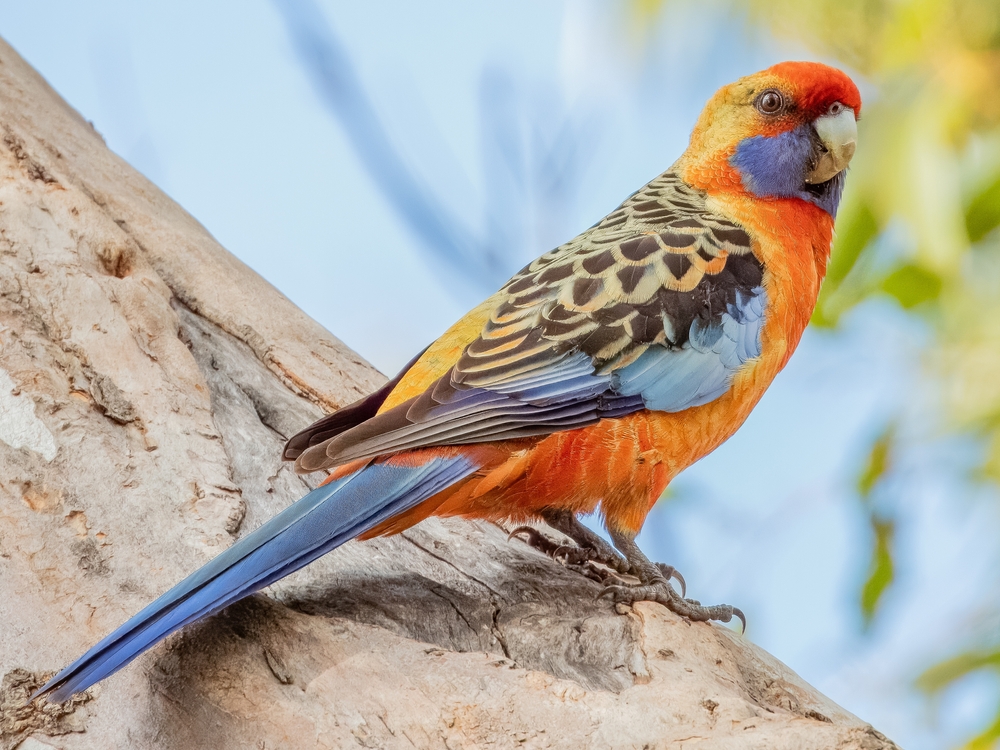Its closest relative is the Rose-ringed Parakeet (Psittacula krameri), which is smaller and lacks the maroon shoulder patch. Both species belong to the same genus and share similar habits.
About
The Alexandrine Parakeet (Psittacula eupatria) is a large and charismatic parrot belonging to the Psittaculidae family, which includes Asian ring-necked and rose-ringed parakeets. Native to South and Southeast Asia, it ranges from Afghanistan and India through Myanmar, Thailand, and Cambodia, with introduced populations in Europe and the Middle East. Revered since ancient times, it was named after Alexander the Great, who is believed to have transported these birds from India to Greece and the Mediterranean.
Measuring 56 to 62 centimeters (22 to 24 inches) in length, including its long tail, the Alexandrine Parakeet is one of the largest parakeets. It displays predominantly green plumage, a bluish-grey sheen on the cheeks and nape, a striking maroon patch on the wings, and a massive red bill. Adult males are distinguished by a black-and-rose collar encircling the neck, while females and juveniles lack this feature.
These birds are highly intelligent and social, known for their loud calls and ability to mimic human speech when kept in captivity. In the wild, they live in flocks, often foraging in cultivated areas, which sometimes brings them into conflict with farmers. Their diet consists mainly of seeds, fruits, berries, nuts, and blossoms.
Breeding takes place in tree cavities, where females lay three to four eggs. Both parents contribute to chick rearing, and the young fledge after about seven weeks. Outside the breeding season, Alexandrine Parakeets are highly mobile, often forming large communal roosts.
Although widespread, the species is under pressure from habitat loss and trapping for the pet trade. It is listed as Near Threatened due to declining wild populations in several parts of its range. Nonetheless, its adaptability has enabled it to persist in urban and agricultural areas.
The Alexandrine Parakeet, with its beauty, intelligence, and historical significance, remains one of Asia’s most remarkable parrots.
Physical Characteristics
The Alexandrine Parakeet is a large, long-tailed parrot, easily recognized by its size, vivid plumage, and distinctive shoulder patch.
Plumage: Adults are predominantly bright green, with a bluish tinge on the cheeks and nape. The most distinguishing feature is the maroon-red patch on the shoulders (wing coverts). The underparts are lighter green, and the tail feathers are green with yellow tips. Males have a black neck ring and a pink nape band that develop by the age of 3 years, while females and juveniles lack these markings.
Head & Beak: The head is relatively large and rounded, with a powerful red beak that has a yellowish tip. The eyes are pale yellow, encircled by a narrow white eye-ring.
Body & Wings: The body is sleek and streamlined, suited for agile flight. Wings are long and pointed, enabling swift and direct movements. The tail is elongated and graduated, with central feathers extending well beyond the body length.
Size:
-
Length (Body and Tail): 22–24 in (56–62 cm), with the tail making up more than half the total length.
-
Wingspan: About 7–8 in (18–20 cm) across per wing.
-
Tail Length: 12–14 in (30–36 cm).
Weight:
-
Adult Male: 7.9–9.9 oz (225–280 g).
-
Adult Female: 7.0–8.8 oz (200–250 g).
The Alexandrine Parakeet’s large size, long tapering tail, and maroon shoulder patch make it one of the most distinctive Asian parakeets, standing out from smaller relatives like the Rose-ringed Parakeet.
Reproduction
The reproductive cycle of the Alexandrine Parakeet follows the seasonal rhythms of South and Southeast Asia, with nesting aligned to the cooler, drier months.
1. Mating and Courtship:
Alexandrine Parakeets are monogamous and form strong pair bonds. Courtship includes mutual preening, feeding displays, and vocal exchanges. Pairs often remain together for life.
2. Breeding Season:
The breeding season usually occurs from November to April, though timing varies by region. Nesting coincides with the availability of secure tree cavities and stable weather.
3. Nesting:
They nest in natural tree hollows or sometimes in old woodpecker holes, usually high above ground for safety. Nest sites are reused over multiple seasons when suitable.
4. Egg Laying and Incubation:
The female typically lays 2–4 eggs, occasionally up to 6. Eggs are white, oval, and smooth-shelled. Incubation lasts about 24–28 days, performed mainly by the female while the male guards and feeds her.
5. Hatching and Chick Development:
Chicks hatch blind and helpless, covered in sparse white down. The female broods them for the first weeks, while both parents supply food. Parents regurgitate seeds, fruit, and soft plant matter to feed their young.
6. Fledging:
Young parakeets fledge at about 7–8 weeks, but remain dependent on their parents for food and protection for another 2–3 weeks.
7. Sexual Maturity:
They reach breeding maturity at 3 years, when males develop the full black neck ring and pink nape band.
The Alexandrine Parakeet’s reliance on tree cavities makes it especially vulnerable to habitat loss, as large nesting trees are often removed through logging or urban expansion.
Lifespan
The Alexandrine Parakeet is a long-lived parrot, with survival shaped by predation, habitat stability, and human care in captivity.
Lifespan in the Wild:
In natural habitats, Alexandrine Parakeets live about 20–25 years. Juvenile mortality is relatively high due to predation by raptors, snakes, and nest competition, but adults that secure territories often live for two decades or more.
Lifespan in Captivity:
With proper diet, veterinary care, and enrichment, Alexandrine Parakeets can live up to 30–40 years, and in some cases slightly longer. Their longevity makes them a lifetime companion in aviculture.
Threats to the Alexandrine Parakeet:
-
Habitat Loss: Deforestation and removal of old trees reduce available nesting sites.
-
Trapping and Trade: Popular in the pet trade, they are often trapped illegally, reducing wild populations.
-
Predation: Eggs and chicks are preyed upon by snakes, monitor lizards, and birds of prey.
-
Competition: Nest site competition with other parrots, mynas, and invasive species reduces breeding success.
Conservation Efforts:
The Alexandrine Parakeet is listed as Near Threatened on the IUCN Red List. Protection of forest habitats, regulation of trade, and nest box programs have been important steps in safeguarding populations.
Eating Habits
The Alexandrine Parakeet is a primarily herbivorous bird, with a diet centered on seeds, fruits, and plant matter.
Diet:
Their natural diet includes seeds, fruits, berries, buds, flowers, and nuts. They also consume cultivated crops such as maize, rice, and millet, which often brings them into conflict with farmers. Occasionally, they may eat small amounts of insects or larvae, especially when feeding chicks.
Foraging Strategy:
These parakeets forage both in the canopy and on the ground. They use their powerful red beaks to crack open hard seeds and nuts and to strip bark or buds. They are agile climbers, often hanging upside down to reach food.
Feeding Behavior:
Highly social, they often feed in pairs or small flocks, and during non-breeding seasons may gather in large groups around abundant food sources. They are noisy when feeding, their calls carrying over long distances.
Crop Raiding:
In agricultural areas, Alexandrine Parakeets are known to raid orchards and grain fields, feeding on mangoes, guavas, pomegranates, maize, and millet. This has earned them a reputation as crop pests in parts of their range.
Feeding Young:
Parents regurgitate semi-digested seeds, fruits, and soft plant matter to feed chicks. This ensures that young birds receive a nutrient-rich and easily digestible diet.
Seasonal Feeding:
Their diet varies with seasonal availability. During flowering and fruiting seasons, they rely heavily on blossoms and ripe fruits, while in drier months, they consume more seeds and grains.
The Alexandrine Parakeet’s versatile diet and strong beak allow it to exploit both wild and cultivated food sources, contributing to its success as a widespread parrot species across Asia.
Uniqueness
The Alexandrine Parakeet is one of the most distinctive Asian parrots, notable for its size, cultural importance, and adaptability:
Largest of the Genus: It is the largest member of the genus Psittacula, easily distinguished from smaller relatives like the Rose-ringed Parakeet by its greater body size and long tail.
Maroon Shoulder Patch: The bold maroon-red shoulder patch, visible on both sexes, is its most defining feature and helps separate it from similar parakeet species.
Dimorphic Neck Rings: Males develop a black neck ring and pink nape band by age 3, a striking sexual dimorphism absent in females and juveniles.
Historical Significance: Named after Alexander the Great, who is believed to have introduced this parakeet to Europe and the Mediterranean. Its presence in ancient art and literature highlights its long association with humans.
Mimicry Ability: Like many parrots, Alexandrine Parakeets can imitate human speech and sounds, though not as fluently as larger parrots. Their vocalizations are loud, carrying over long distances.
Adaptability: Despite habitat loss, they thrive in both forests and urban environments, nesting in city parks and feeding on cultivated crops.
Conservation Status: Listed as Near Threatened, it remains widespread but is declining due to trapping for the pet trade and habitat degradation.
The Alexandrine Parakeet’s combination of large size, cultural legacy, and adaptability makes it one of the most unique and recognizable parrot species in Asia.
Be the First to Share Photos of This Species.
FAQ’s
1. What is the closest species to the Alexandrine Parakeet?
2. How does the Alexandrine Parakeet compare to other parakeets?
It is noticeably larger than most Asian parakeets, reaching up to 24 in (62 cm) with its long tail. Its maroon shoulder patch and stronger beak set it apart from species like the Plum-headed or Rose-ringed Parakeet.
3. What national parks provide the best opportunities to see an Alexandrine Parakeet?
Here are some possible locations to see this parakeet in the wild:
-
Keoladeo National Park, India – Commonly seen in flocks around wetlands and woodlands.
-
Gir National Park, India – Found in dry deciduous forests alongside other parakeet species.
-
Chitwan National Park, Nepal – Frequently observed in forest edges and cultivated clearings.
-
Yala National Park, Sri Lanka – Seen in open forest and agricultural areas.
-
Khao Yai National Park, Thailand – Present in evergreen and mixed deciduous forests.






































































